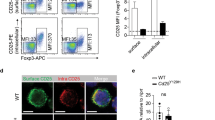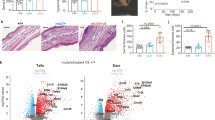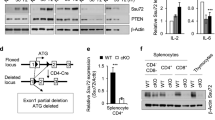Abstract
Itch is an E3 ubiquitin ligase that is disrupted in nonagouti-lethal or itchy mice. Itch deficiency leads to severe immune and inflammatory disorders and constant itching of the skin. Here we show that Itch−/− T cells show an activated phenotype and enhanced proliferation. Production of the type 2 T helper (TH2) cell cytokines interleukin 4 (IL-4) and IL-5 by Itch−/− T cells was augmented upon stimulation, and the TH2-dependent serum concentrations of immunoglobulin G1 (IgG1) and IgE in itchy mice were also increased. Molecularly, Itch associated with and induced ubiquitination of JunB, a transcription factor that is involved in TH2 differentiation. These results provide a molecular link between Itch deficiency and the aberrant activation of immune responses in itchy mice.
This is a preview of subscription content, access via your institution
Access options
Subscribe to this journal
Receive 12 print issues and online access
$209.00 per year
only $17.42 per issue
Buy this article
- Purchase on Springer Link
- Instant access to full article PDF
Prices may be subject to local taxes which are calculated during checkout






Similar content being viewed by others
References
Hershko, A. & Ciechanover, A. The ubiquitin system. Annu. Rev. Biochem. 67, 425–479 (1998).
Hicke, L. Gettin' down with ubiquitin: turning off cell-surface receptors, transporters and channels. Trends Cell Biol. 9, 107–112 (1999).
Kaiser, P., Flick, K., Wittenberg, C. & Reed, S. I. Regulation of transcription by ubiquitination without proteolysis: Cdc34/SCF(Met30)-mediated inactivation of the transcription factor Met4. Cell 102, 303–314 (2000).
Hoppe, T. et al. Activation of a membrane-bound transcription factor by regulated ubiquitin/proteasome-dependent processing. Cell 102, 577–586 (2000).
Fang, D. & Liu, Y.-C. Proteolysis-independent regulation of phosphatidylinositol 3-kinase by Cbl-b-mediated ubiquitination in T cells. Nature Immunol. 2, 870–875 (2001).
Deng, L. et al. Activation of the IκB kinase complex by TRAF6 requires a dimeric ubiquitin-conjugating enzyme complex and a unique polyubiquitin chain. Cell 103, 351–361 (2000).
Kishino, T., Lalande, M. & Wagstaff, J. UBE3A/E6-AP mutations cause Angelman syndrome. Nature Genet. 15, 70–73 (1997).
Shimura, H. et al. Ubiquitination of a new form of α-synuclein by parkin from human brain: implications for Parkinson's disease. Science 293, 263–269 (2001).
Imai, Y. et al. An unfolded putative transmembrane polypeptide, which can lead to endoplasmic reticulum stress, is a substrate of Parkin. Cell 105, 891–902 (2001).
Hustad, C. M. et al. Molecular genetic characterization of six recessive viable alleles of the mouse agouti locus. Genetics 140, 255–265 (1995).
Perry, W. L. et al. The itchy locus encodes a novel ubiquitin protein ligase that is disrupted in a18H mice. Nature Genet. 18, 143–146 (1998).
Sudol, M. & Hunter, T. NeW wrinkles for an old domain. Cell 103, 1001–1004 (2000).
Mosmann, T. R. & Coffman, R. L. TH1 and TH2 cells: different patterns of lymphokine secretion lead to different functional properties. Annu. Rev. Immunol. 7, 145–173 (1989).
Paul, W. E. & Seder, R. A. Lymphocyte responses and cytokines. Cell 76, 241–251 (1994).
Qiu, L. et al. Recognition and ubiquitination of Notch by Itch, a Hect-type E3 ubiquitin Ligase. J. Biol. Chem. 275, 35734–35737 (2000).
Robson MacDonald, H., Wilson, A. & Radtke, F. Notch1 and T-cell development: insights from conditional knockout mice. Trends Immunol. 22, 155–160 (2001).
Shultz, L. D. et al. Mutations at the murine motheaten locus are within the hematopoietic cell protein-tyrosine phosphatase (Hcph) gene. Cell 73, 1445–1454 (1993).
Tsui, H. W., Siminovitch, K. A., de Souza, L. & Tsui, F. W. Motheaten and viable motheaten mice have mutations in the haematopoietic cell phosphatase gene. Nature Genet. 4, 124–129 (1993).
Healy, J. I. & Goodnow, C. C. Positive versus negative signaling by lymphocyte antigen receptors. Annu. Rev. Immunol. 16, 645–670 (1998).
Li, B., Tournier, C., Davis, R. J. & Flavell, R. A. Regulation of IL-4 expression by the transcription factor JunB during T helper cell differentiation. EMBO J. 18, 420–432 (1999).
Abbas, A. K., Murphy, K. M. & Sher, A. Functional diversity of helper T lymphocytes. Nature 383, 787–793 (1996).
Romagnani, S. The Th1/Th2 paradigm. Immunol. Today 18, 263–266 (1997).
Ho, I. C., Hodge, M. R., Rooney, J. W. & Glimcher, L. H. The proto-oncogene c-maf is responsible for tissue-specific expression of interleukin-4. Cell 85, 973–983 (1996).
Zheng, W. & Flavell, R. A. The transcription factor GATA-3 is necessary and sufficient for TH2 cytokine gene expression in CD4 T cells. Cell 89, 587–596 (1997).
Szabo, S. J. et al. A novel transcription factor, T-bet, directs TH1 lineage commitment. Cell 100, 655–669 (2000).
Mullen, A. C. et al. Role of T-bet in commitment of TH1 cells before IL-12-dependent selection. Science 292, 1907–1910 (2001).
Sperling, A. I. & Bluestone, J. A. ICOS costimulation: it's not just for TH2 cells anymore. Nature Immunol. 2, 573–574 (2001).
Treier, M., Staszewski, L. M. & Bohmann, D. Ubiquitin-dependent c-Jun degradation in vivo is mediated by the δ domain. Cell 78, 787–798 (1994).
Fang, D. et al. Cbl-b, a RING-type E3 ubiquitin ligase, targets phosphatidylinositol 3-kinase for ubiquitination in T cells. J. Biol. Chem. 276, 4872–4878 (2001).
Joazeiro, C. A. et al. The tyrosine kinase negative regulator c-Cbl as a RING-type, E2-dependent ubiquitin-protein ligase. Science 286, 309–312 (1999).
Acknowledgements
We thank A. Altman, Y. Tanaka, M. Jeon and others at the Division of Cell Biology for support and suggestions. Supported by grants from National Institutes of Health (RO1DK56558) and American Cancer Society (to Y.-C. L.).
Author information
Authors and Affiliations
Corresponding author
Ethics declarations
Competing interests
The authors declare no competing financial interests.
Supplementary information
Web Figure 1.
Effect of Itch on reporter-based transactivation. Jurkat cells were transfected with either AP-1- or NF-κB–driven luciferase reporter in the absence or the presence of wild-type Itch or Itch CA mutant. The relative luciferase activity was normalized and presented as fold increase over the basal activity. Thirty hours after transfection, cells were left untreated or stimulated with anti-CD3 for 6 h, collected and washed twice with PBS. Luciferase activity in the cell extracts was determined in triplicate by luminometry. Each experiment was repeated at least three times. (GIF 11 kb)
Rights and permissions
About this article
Cite this article
Fang, D., Elly, C., Gao, B. et al. Dysregulation of T lymphocyte function in itchy mice: a role for Itch in TH2 differentiation. Nat Immunol 3, 281–287 (2002). https://doi.org/10.1038/ni763
Received:
Accepted:
Published:
Issue Date:
DOI: https://doi.org/10.1038/ni763
This article is cited by
-
Silencing Itch in human peripheral blood monocytes promotes their differentiation into osteoclasts
Molecular Biology Reports (2022)
-
Rethinking peripheral T cell tolerance: checkpoints across a T cell’s journey
Nature Reviews Immunology (2021)
-
Integrative proteomics reveals an increase in non-degradative ubiquitylation in activated CD4+ T cells
Nature Immunology (2019)
-
The E3 ubiquitin ligase Itch is required for B-cell development
Scientific Reports (2019)
-
K27-linked ubiquitination of BRAF by ITCH engages cytokine response to maintain MEK-ERK signaling
Nature Communications (2019)



